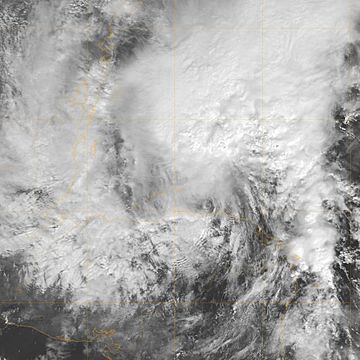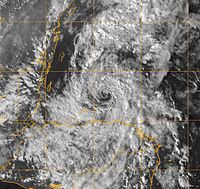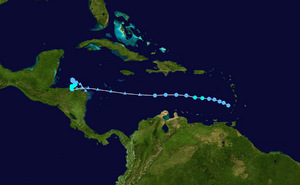Tropical Storm Gamma facts for kids
| Tropical storm (SSHWS/NWS) | |

Tropical Storm Gamma off the coast of Honduras
|
|
| Formed | November 13, 2005 |
|---|---|
| Dissipated | November 20, 2005 |
| Highest winds | 1-minute sustained: 50 mph (85 km/h) |
| Lowest pressure | 1002 mbar (hPa); 29.59 inHg |
| Fatalities | 37 direct, 4 indirect |
| Damage | $18 million (2005 USD) |
| Areas affected | Lesser Antilles, Honduras, Belize |
| Part of the 2005 Atlantic hurricane season | |
Tropical Storm Gamma was the twenty-fourth named storm during the 2005 Atlantic hurricane season. It started in the eastern Caribbean Sea but weakened quickly because of strong winds high up in the atmosphere, called wind shear. On November 18, it got stronger again and became a tropical storm for a few more days. It finally faded away near the coast of Honduras on November 20. Even though Gamma never hit land directly, it caused some damage in the Lesser Antilles and more serious damage in Honduras.
Contents
How Tropical Storm Gamma Formed and Moved
The National Hurricane Center started watching a tropical wave that would later become Gamma around November 11. This system officially became a tropical depression on November 13, after it had passed the Lesser Antilles. At first, experts thought it would grow into a strong tropical storm or even a weak hurricane as it moved across the Caribbean Sea.
However, another weather system developing nearby started pushing strong wind shear onto the depression on November 14. This wind shear made the depression much weaker, turning it into a tropical low. Because of this, the warnings for the storm were stopped for a while. Later, scientists looked back at the data and found that the depression had likely become a tropical storm for a short time on November 15, but it wasn't given a name then.

As the remains of the storm moved west, the other weather system that caused the wind shear moved over land in Nicaragua and quickly weakened. This meant less wind shear for the storm's leftover parts. Near Honduras, the two systems came together and quickly gained the features of a tropical cyclone on November 18. At this point, it was upgraded directly to a tropical storm and officially named Gamma. It's not fully clear if Gamma's old parts absorbed the other system, or if it happened the other way around. However, forecasters at the National Hurricane Center thought it was more likely that Gamma absorbed the other system.
Gamma got a little stronger, reaching its top wind speed of 50 mph (85 km/h) that day. But a new weather system moving into the Gulf of Mexico stopped it from getting any stronger. Gamma stayed just north of the Honduran coast for about a day. Then, it weakened back into a tropical depression as it started to get pulled into the new weather system. By November 20, strong wind shear had completely broken apart Gamma, and all warnings were stopped. The last parts of Gamma were later absorbed into the approaching weather system. Tropical Storm Gamma never actually made landfall.
Preparing for the Storm
Since the storm was not expected to hit land directly, people in Honduras didn't make many special preparations. However, Gamma caused non-stop rain for more than a day as it stayed offshore. This heavy rain led to floods that forced over 23,000 people to leave their homes and find safety.
How Tropical Storm Gamma Affected People and Places
| Country | Total | Direct deaths |
||||
|---|---|---|---|---|---|---|
| Belize | 3 | 3 | ||||
| Honduras | 34 | 34 | ||||
| St. Vincent | 2 | 0 | ||||
| Jamaica | 2 | 0 | ||||
| Totals | 41 | 37 | ||||
| Because of differing sources, totals may not match. | ||||||
By January 24, 2006, a total of forty-one people were reported to have died because of Tropical Storm Gamma. Thirty-seven of these deaths were directly caused by the storm, mostly in Honduras. Thirteen people were also reported missing in Honduras.
Impact in Honduras
In Honduras, thirty-four people died, and at least thirteen others were missing. All these deaths were due to flooding and mudslides, not from strong winds, because tropical storm-force winds did not reach the mainland.
According to the Honduran civil emergency committee (COCEP), many bridges were washed away, and about 2,000 homes were destroyed. The National Hurricane Center reported that 10 bridges were destroyed by floods, and 7 more were damaged. Also, 5,200 acres of banana crops were ruined, causing about $13-18 million (in 2005 US dollars) in damage. On Roatan Island, an unofficial report said 4.44 inches of rain fell.
Impact in Belize
Five fishermen who were at sea during Tropical Storm Gamma went missing. By November 25, they were believed to have died after five unidentified bodies were found on the Honduran coast. Three people were killed in a plane crash that was partly blamed on the weather from Gamma's outer rain bands. Other effects in Belize were very small.
Impact on Caribbean Islands
Two people died from a mudslide in St. Vincent and the Grenadines. This happened when Tropical Depression Twenty-Seven (which later became Tropical Storm Gamma) passed close to the island. Seven homes in that area were also destroyed by floodwaters, and others were damaged.
Other effects across the rest of the Lesser Antilles were minor, no worse than a typical heavy rain event. Also, two fishermen reported dead in Jamaica were thought to have been killed by Gamma.
After the Storm and Its Name
After Gamma slowly moved away from land, government officials in Honduras used helicopters to rescue people and families stuck by floodwaters. UN agencies also started flying in food and water to the areas that were hit.
The government of Andalucía in Spain gave 40 million lempiras to help with disaster relief. The United States sent helicopters to help deliver food to the people affected by the storm.
Because the damage from Gamma was not severe enough, the name Gamma was not "retired." This means it can be used again in the future if all the regular hurricane names are used up.
Naming and Records Set by Gamma
After all twenty-one regular hurricane names for the 2005 season were used up (after Hurricane Wilma), the Greek alphabet was used. The first storm named this way was Tropical Storm Alpha. This storm was named Gamma once it was known to have reached tropical storm strength after it got stronger again. This was the very first time the name Gamma had been used for a tropical cyclone.
Tropical Storm Gamma was the twenty-fourth tropical storm to form in any single Atlantic hurricane season. This means Gamma holds the record for being the earliest twenty-fourth tropical storm, reaching tropical storm strength on November 18. Gamma also helped extend the 2005 season's record for tropical storms to twenty-four. This record was later broken four more times, ending with twenty-eight storms after Tropical Storm Zeta and an unnamed subtropical storm that was added later. Gamma also tied the record set during the 1992 Pacific hurricane season for the most storms in one ocean basin watched by NOAA.
Related pages


